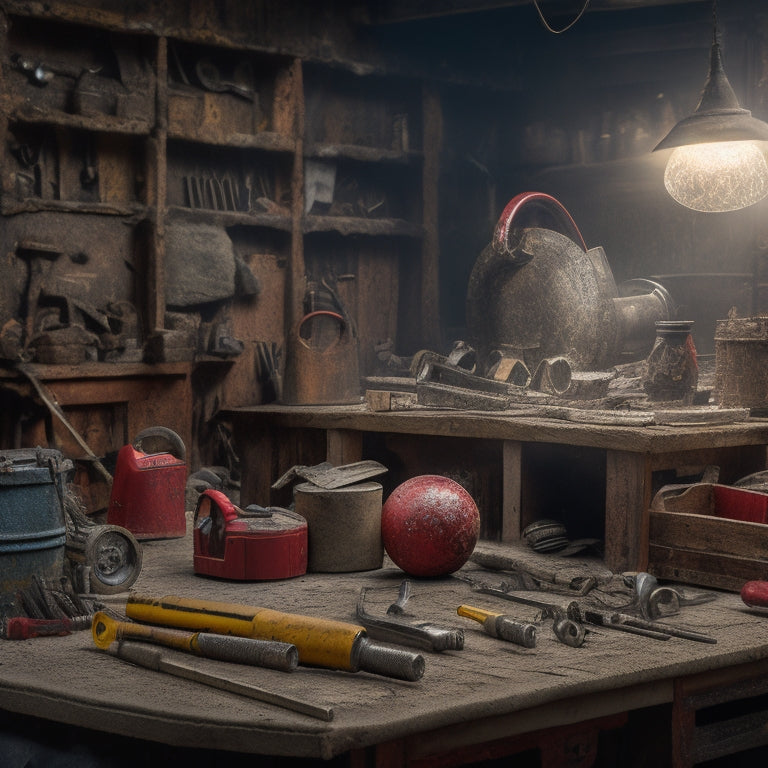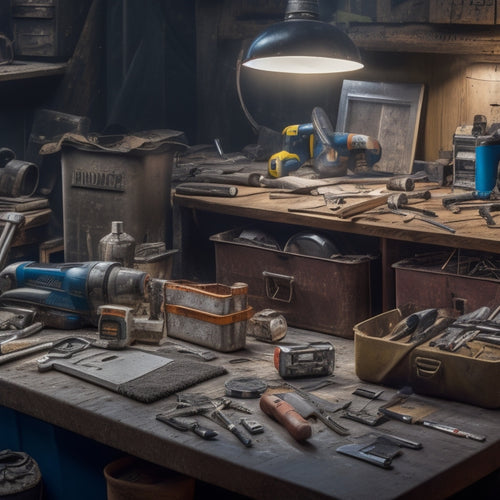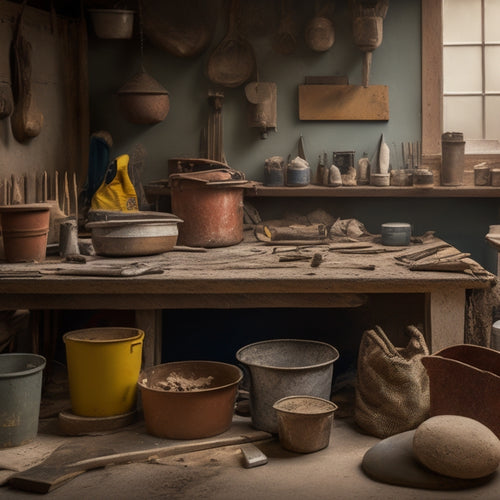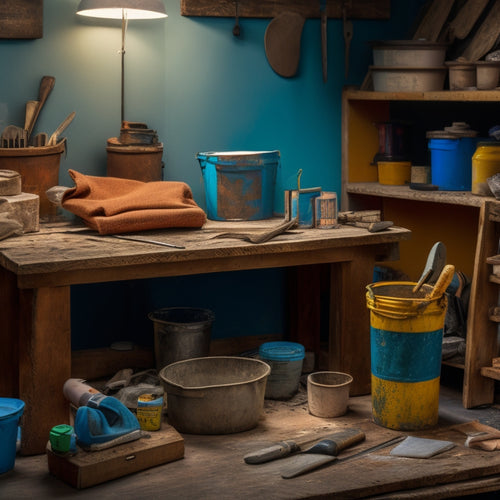
7 Tool Myths DIY Renovators Need to Know
Share
You're likely holding onto some misconceptions about the tools in your DIY renovator's arsenal, and that's costing you time, money, and quality in your projects. You might think a larger trowel is always better, but it's not - the right size depends on the job. You may believe a plastering blade is essential, but it's not; putty knives and trowels can achieve similar results. And don't even get started on joint knives - they're not as useful as you think. By shedding these myths, you'll uncover more efficient ways to work and better results. But there's more to learn about the tools you're using - and not using.
Key Takeaways
• Right trowel size and technique are crucial for efficient material application and removal, preventing air pockets and uneven surfaces.
• Mastering plastering techniques is more important than relying on a specific tool, as putty knives and trowels offer versatility for various tasks.
• Investing in high-quality, ergonomic tools may seem expensive initially, but they provide long-term savings through durability and improved performance.
• Familiarity with various sandpaper grits and systematic sanding approaches is essential for achieving a smooth, even finish in DIY renovation projects.
• Cheap tools may lead to increased costs due to frequent replacements, highlighting the importance of balancing cost with value when selecting tools.
Trowel Size Matters Most
When it comes to getting the job done efficiently, selecting the right trowel size is essential, as it directly affects the amount of material you can apply and remove in a single pass. You can't just grab any trowel off the shelf and expect to achieve professional results.
The right trowel size depends on the type of material you're working with and the surface area you need to cover. For example, a larger trowel is ideal for applying thick layers of material, while a smaller trowel is better suited for detail work and precision applications.
Mastering various trowel techniques is also vital for achieving a flawless finish. You need to know when to use a push stroke versus a pull stroke, and how to adjust your pressure to avoid creating air pockets or uneven surfaces.
Familiarize yourself with different trowel types, such as notched, v-notched, and square-notched trowels, each designed for specific materials and applications.
Hawk Is Only for Pros
You've likely heard that hawks are only for seasoned pros, but that's a myth that can hold you back from achieving a superior finish. In reality, hawks are incredibly versatile tools that can benefit DIY renovators of all skill levels.
With the right hawk techniques, you can achieve a smooth, even application of plaster, concrete, or drywall compound. The key is to practice and master the basic strokes, such as the 'push-pull' and 'figure-eight' motions.
Once you're comfortable with these fundamental techniques, you can experiment with more advanced hawk techniques, like using different angles and pressures to achieve specific textures and effects.
Don't be intimidated by the idea of using a hawk – with a little patience and practice, you'll be amazed at the results you can achieve. Remember, it's not about being a pro; it's about mastering the tool and understanding its capabilities.
Plastering Blade Is Essential
By assuming a plastering blade is vital, many DIY renovators limit their options and overlook the versatility of other tools that can achieve similar results. You don't necessarily need a plastering blade to get the job done. In fact, using a putty knife or a trowel can be just as effective, depending on the specific task at hand.
Mastering various plastering techniques is more important than relying on a single tool. For instance, you can use a putty knife to apply and smooth out plaster, or a trowel to create texture and patterns. These tools can also be used for other tasks, making them a more versatile investment.
Proper blade maintenance is also important, but it's not a reason to make it the centerpiece of your toolkit. A dull or damaged blade can hinder your progress, but it's easily replaced or sharpened.
Don't let the assumption that a plastering blade is vital hold you back from exploring other options and techniques. Expand your toolkit and skills to become a more efficient and effective DIY renovator.
Sandpaper Is a Must-Have
Two sheets of sandpaper in your toolkit don't make you a master DIY renovator. You need to understand the nuances of sandpaper grit and sanding techniques to get the job done efficiently.
Having a variety of grits on hand is essential, but it's not just about having them - it's about knowing when to use each one. You'll need coarse grits (80-100) for removing old finishes and smoothing out rough surfaces, medium grits (120-150) for general sanding, and fine grits (220-240) for final polishing.
Don't fall into the trap of using the wrong grit for the task at hand. You'll end up wasting time and effort. Instead, develop a systematic approach to sanding, starting with coarse grits and progressing to finer ones. This will help you achieve a smooth, even finish.
Putty Knife Is for Fillers
Your putty knife isn't just a scraper, but a precision tool for applying and shaping fillers, and it's essential to master its proper use to achieve a seamless repair.
You'll be surprised at the putty knife's versatility – it can be used to apply, smooth, and feather fillers with precision. To get the most out of your putty knife, make sure to maintain it properly. Clean it regularly to prevent dried filler from building up, and store it in a dry place to prevent rust.
When applying fillers, hold the putty knife at a 45-degree angle and press it firmly onto the surface. This will help you achieve a smooth, even layer.
To shape and feather the filler, use long, sweeping strokes, applying gentle to moderate pressure. Remember to keep your putty knife sharp and well-maintained, as a dull blade can lead to uneven applications and a poor finish.
Joint Knife Is Overrated
You've probably been led to believe that a joint knife is a must-have in your DIY toolkit, but the truth is, it's not as essential as you think.
When you take a closer look, you'll find that the limited blade options, difficulty in scraping, and heavy, bulky design make it more of a hindrance than a help.
It's time to rethink your reliance on this overhyped tool and explore better alternatives.
Limited Blade Options
Despite its widespread popularity, the joint knife's versatility is often overstated, and its limited blade options can hinder your ability to tackle specific tasks efficiently. While it's great for general-purpose tasks, you'll find it falls short when you need precision cutting or specialized blade versatility.
For instance, when working with drywall, you'll struggle to get a clean cut with a joint knife. The blade's rigidity and limited flexibility make it difficult to navigate tight spaces or curved surfaces, resulting in uneven cuts and wasted material.
You may think you're saving time by using a joint knife for every task, but in reality, you're sacrificing cutting precision and efficiency. Don't get caught in the trap of relying on a single tool for everything.
Instead, invest in specialized blades designed for specific tasks, such as drywall blades or putty knives. By doing so, you'll achieve better results, reduce waste, and increase your overall productivity.
Difficulty in Scraping
Three common scraping tasks - removing old adhesives, scraping off dried paint, and smoothing rough surfaces - are where the joint knife's limitations become glaringly apparent.
You'll find yourself struggling to make progress, applying excessive force, and still not getting the desired results. It's not because you're lacking in skill or technique; it's because the joint knife simply isn't designed for these tasks.
You need to master alternative scraping techniques and invest in effective tools specifically designed for these jobs. For instance, a putty knife or a scraper with a curved or angled blade can help you tackle tough adhesives and dried paint.
When it comes to smoothing rough surfaces, a sanding block or an orbital sander can be a game-changer. Don't waste your time and energy on a joint knife that's not up to the task.
Instead, expand your toolkit and develop the skills to match. With the right tools and techniques, you'll be able to tackle even the most challenging scraping tasks with ease and precision.
Heavy and Bulky Design
The joint knife's hefty weight and cumbersome design make it awkward to maneuver in tight spaces, causing fatigue and discomfort during extended use. You might think that a heavy tool is more effective, but it's actually a hindrance. Heavy tool management is essential, especially when working on intricate projects.
Here are some ergonomic design benefits you should consider:
-
Reduced fatigue: Lighter tools allow you to work longer without feeling exhausted.
-
Increased precision: With less weight, you have more control over your movements, resulting in more accurate cuts and scrapes.
-
Improved maneuverability: Ergonomic tools fit comfortably in your hand, making it easier to navigate tight spaces and corners.
- Enhanced comfort: Well-designed tools reduce strain on your wrists and hands, minimizing the risk of injury.
Darby Tool Is a Luxury
You've likely heard that Darby tools are only for the affluent, reserved for those with deep pockets and a penchant for luxury. But is this really the case?
The truth is, Darby tools offer a range of benefits that make them a worthwhile investment for any serious DIY renovator. For one, they're built to last, with high-quality materials and construction that can withstand heavy use. This means you'll get more bang for your buck in the long run, as you won't need to constantly replace cheap, flimsy tools.
Additionally, Darby tools are designed for precision and ease of use, making even the most complex tasks a breeze.
If you're not ready to invest in a Darby tool just yet, there are alternatives available that can still provide you with similar benefits. Look for tools made with durable materials and designed with ergonomics in mind. While they may not be as high-end as Darby, they'll still get the job done.
Frequently Asked Questions
Can You Use a Trowel for Applying Joint Compound?
You're wondering if you can use a trowel for applying joint compound? The answer is yes, but not just any trowel.
You'll need a specific type, like a 4-6 inch joint compound trowel or a putty knife, designed for joint compound application.
These trowels have a curved or angled blade, allowing for smooth, even spreading and feathering of the compound.
With the right tool, you'll achieve a professional-looking finish.
What's the Purpose of a Notched Trowel in Plastering?
When it comes to plastering, you'll want to use a notched trowel, which allows you to apply the perfect amount of plaster to your surface. The notches create a controlled, even layer, ensuring a strong bond.
You'll get the best results by selecting the right trowel size for your project - a smaller trowel for tight spaces and a larger one for bigger areas.
With a notched trowel, you'll achieve a smooth, professional-looking finish, and enjoy the benefits of increased efficiency and reduced waste.
Can I Use a Putty Knife for Scraping Old Adhesive?
Can you really use a putty knife for scraping old adhesive?
Investigate the truth: a putty knife's flexibility makes it inadequate for removing stubborn adhesives. You'll end up scratching the surface instead.
Opt for putty knife alternatives like a scraper or a dedicated adhesive removal tool. These tools provide the necessary rigidity and leverage for efficient adhesive removal techniques.
Don't risk damaging your surface; choose the right tool for the job.
Do I Need a Specialized Tool for Cutting Plaster Mesh?
You're wondering if you need a specialized tool for cutting plaster mesh. The answer is, it depends on the job's scope and your desired outcome.
For small areas, a utility knife or scissors can work.
However, for larger projects, invest in a mesh cutter or a pair of tin snips to make clean cuts.
Mastering cutting techniques, such as scoring and snapping, will also help you achieve professional-looking results.
Can I Use a Joint Knife for Applying Thinset Mortar?
Coincidentally, you're about to tackle another messy task - applying thinset mortar. You're wondering if your trusty joint knife can handle the job. Fortunately, it can!
A joint knife's versatility shines in thinset application techniques. Its flat, wide blade allows for smooth, even spreading, while its flexibility helps with feathering edges.
Just be sure to clean it frequently to prevent mortar buildup. With the right technique, your joint knife becomes an indispensable tool for a successful tile installation.
Conclusion
You've made it to the end of the tool myth-busting journey!
Now, you're equipped with the knowledge to separate fact from fiction, and your DIY renovation is about to get a whole lot smoother.
Think of these debunked myths as roadblocks removed from your path to a perfectly plastered wall - you can drive straight to success, no detours needed.
With these truths in your toolkit, you're ready to tackle any project that comes your way.
Related Posts
-

Smart Guide to Buying Second-Hand Renovation Tools
When buying second-hand renovation tools, you'll want to set clear renovation goals and a realistic budget to priorit...
-

What Plastering Tools Do You Need for Renovation
You'll need a range of specialized tools to tackle a plastering renovation project efficiently and effectively. Essen...
-

DIY Plastering Supply Checklist for Home Renovation
To tackle a DIY plastering project for your home renovation, you'll need a solid checklist of supplies. Start with es...


